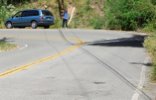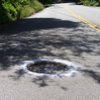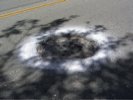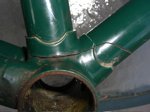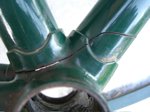Late Thursday afternoon, I went out for a short ride through the Berkeley and Oakland hills; just a way to wake up my body for a planned 600-kilometer (387.5-mile) ride this weekend. I also wanted to see how my “new” bike — a beautifully painted old Bridgestone RB-1 frame I just had built up with parts from my old RB-1 — handled on a course I know pretty well. The route took me south along Skyline Boulevard past the place where I had a pretty bad crash in January 1991. Whenever I ride past the spot, I remember the fall and the aftermath. It all came back Thursday, too: How quickly I hit the road, the ambulance ride to the hospital, the gruesome picture I took of my face when I got back home.
I turned around, rode back up the hill I had just come down, and headed back toward Berkeley. The road is rolling, with a few short, curving descents and a couple of short climbs. The downhill sections are a little tricky, with some bad pavement. I rounded one right-hand turn, skirted some badly patched asphalt and picked up speed as I headed for a left-hand turn. I was probably going 20 to 25 mph. Just before I got to the curve, I hit a hole in the road and fell hard on my left side. I struck the pavement with enough force that my glasses flew off, lost their lenses, and went skidding down the road. I thought I heard my helmet hit the ground, too, but it didn’t show any signs of damage.
I’m OK. I came out of the crash with road rash on my left knee, hip, hand, elbow and shoulder and a pulled muscle (I think) in my upper back or left shoulder. Oddly, my right elbow also got a pretty good scrape, too, and I had a tennis-ball-sized knot on the inside of my right leg just above the ankle. I wound up going down to Kaiser Hospital in Oakland in an ambulance and spending about four hours there, mostly waiting and watching what was happening with people who were a lot worse off than me. About half an hour after I was rolled into the emergency room, a “Code 3” ambulance (one transporting an urgent case, operating with lights and siren) arrived with a woman in the midst of some sort of seizure; she died about 20 minutes later, about 30 feet from where I was lying. Eventually, a couple of nurses had enough of a breather from the more dire cases that they could spend some time scrubbing out and dressing my abrasions so Kate and I could leave.
What’s shakes me is how quickly and decisively something like this can happen. One second: spinning along, nurturing a picture of middle-aged bike rider as road ace. Next second: lying in the road, groaning, feeling a mixture of shock, fear, pain, and foolishness and wondering, What did I hit? Is there a car behind me? Am I going to get run over? How badly am I hurt? Is the bike trashed? What are my glasses doing over there?
After maybe half a minute or so, I untangled myself from the bike and stood up. A driver coming the other way stopped and asked whether I was OK. I think I told him, or her, that I’d see whether I was or wasn’t. That car moved on. Another came down the hill, the same direction I had been riding. The woman driving, Sylvia, stopped and got out and got me to sit down. I reaized my neck hurt. A cyclist named Dave came down the hill and hit the same hole I did and nearly fell. He cursed and then stopped to help, observing that it was the second time he’d hit that spot and that it was all but invisible because it was in a shady spot. Another rider, Doug, stopped as he rolled up the hill. The three of them convinced me it was a good idea to call 911; Dave made the call, then gave me his phone to try to call Kate; Doug, who lives nearby, agreed to hang onto my bike since I couldn’t take it to the hospital.
After another 20 or 30 minutes, the Oakland Fire Department and paramedics and police showed up. I was put in a neck brace and strapped to a backboard. I warned the paramedics, Elise and Dawn, that I weighed 215 pounds; they hefted me onto their gurney and told me I was the lightest person they’d had to lift all day. Then they drove me down the hill to the hospital. Eventually, I got hold of Kate, and she waited with me until I got cleaned up. When we left, several doctors and nurses, including the young guy who had attempted CPR on the woman who had died, told me to get well and made a point of telling me I needed to get a new bike helmet since I had probably damaged the one I had been wearing.
Friday afternoon, Kate and I went up to Doug’s house to pick up my bike. I was surprised to find that there doesn’t appear to be even a nick in the beautiful paint job (the handlebars are trashed, though). We loaded up the bike and then drove to where I fell. Doug had gone out and spraypainted the rim of the hole, which surrounds a manhole cover. Even though it was about an hour and 45 minutes before the time of day when I hit the spot, the shade was already crossing the road, and, even with the warning paint, I could see how close to invisible the hole was. A foot or so to the right or left, and I would have ridden home without incident (or run into some other obstacle). And I’d be out riding today instead of explaining why I’m not.

